If these walls could talk...
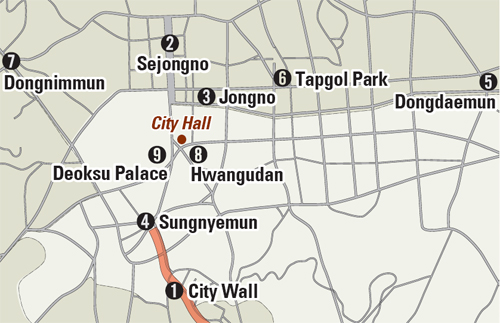
One theme that seems to run through all installments of this series is that of urban development. With Seoul being a highly populated, yet relatively small metropolis, the issue is always a sticky one. Although its value certainly cannot be underestimated, it’s worrisome how it too often comes at the cost of cultural and historical preservation.
And that brings us to another recurring conflict: the tension between preservation and appreciation. Sungnyemun, which we highlighted in the fourth edition of the series, is a classic example of what can happen when the two collide. It was opened to public in 2006 to allow for wider public access, only to be almost completely destroyed by an arsonist expressing his anger toward society.
By Kim Hyung-eun [hkim@joongang.co.kr]
1. City Wall
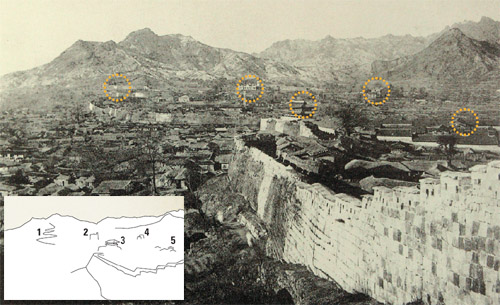
It only made sense to open the series with the city wall. After all, Seoul was a city defined by the wall in shape and location. Being a constant target of attacks by neighboring countries, security was a top priority at the time, and the wall was the first line of defense for the people of Seoul. Today, with just 11 kilometers (seven miles) remaining of its original 18 kilometer structure, the city wall has lost some of its significance, except perhaps as a historic relic at best. It seems to be one of the biggest challenges in the ongoing efforts to restore and recognize important parts of Korea’s cultural heritage.
2. Sejongno
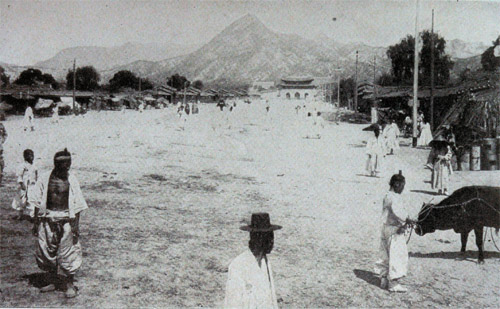
Roads are like a city’s arteries, the pathways through which the city’s lifeblood flows. And Sejongno, the 500-meter-long main road stretching out in front of Gwanghwamun, is one of the biggest in Seoul, so it was a natural second focal point. In August, Koreans will finally be able to see Sejongno, and the southern gate to Gyeongbok Palace, in its full glory when construction of Gwanghwamun Square is complete. The construction process led to the discovery of soil from the original road last year, and treasures from the excavation will also be on display when the road is finally unveiled.
3. Jongno
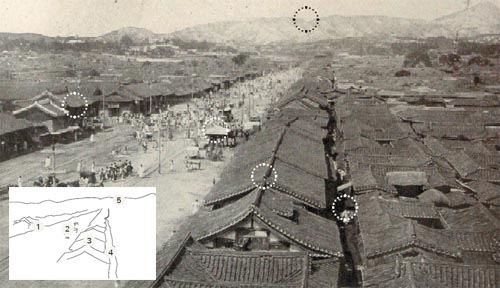
Intersecting Sejongno is another road that we could not exclude from the series: Jongno. Whereas Sejongno saw the passing of people of status to and from the halls of power, Jongno was where real life unfolded, with shopkeepers and laborers going about their daily business and jostling for position with carts and carriages. Pimatgol is one place that seems to best incorporate that spirit. Pimatgol was the alleyway commoners used to avoid the inconvenience of having to prostrate themselves whenever dignitaries passed by. Although the alleyway is set to disappear due to urban redevelopment plans, Pimatgol’s bustling avenue is clearly visible in this photo.
4. Sungnyemun
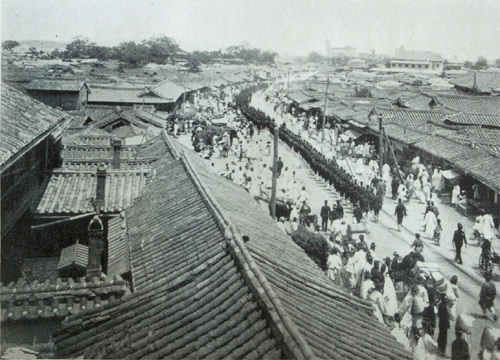
The city’s four main gates and four small gates are also important to the city’s structure. Today, only five gates remain. It may be hard to believe now, but the gates were functioning entrances and exits during the Joseon Dynasty. They opened and closed at designated hours and controlled traffic in and out of the capital. Sungnyemun, Korea’s National Treasure No. 1, is undoubtedly one of Korea’s most symbolic gates. The gate disappeared from view after the 2008 fire, but will reappear again in three years, following a major restoration project.
5. Dongdaemun

It took some deliberation as to which of the other gates we would feature. Dongdaemun made the cut for several reasons. For one, this picture of the gate well captures the changes to come in the final years of the Joseon Dynasty and shows electric poles, tram rails and industrial chimneys. The structure of the gate is something that cannot be seen in any of the city’s seven other gates: It is the only one with extra fortification built outside the gate. Lastly, the ongoing construction of Dongdaemun Design Plaza and Park, set to be erected in 2011, led to several important archeological discoveries, helping people to realize that several meters below the surface, Seoul is full of historic treasures.
6. Tapgol Park
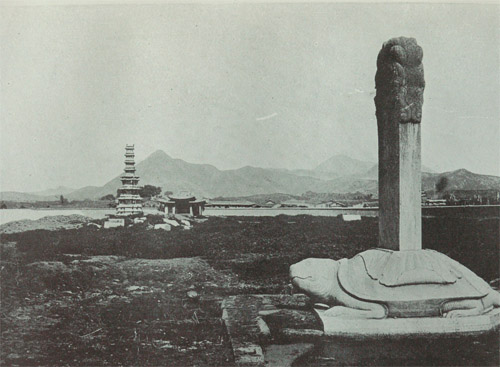
Yes, the winds of change were certainly blowing, so it was only natural that we move on to the short-lived Korean Empire (1897-1910) that ruled before Korea was colonized by the Japanese. The empire and its leader, Gojong (1852-1919), were eager to accept the culture and ways of life of Western, “modern” cities. And Tapgol Park (also known as Pagoda Park) was born as the result of such eagerness. It was Korea’s first modern park. Ahn Chang-mo, professor of architectural history at Kyonggi University, notes how “in other cities, parks emerge after industrialization as a way to clean up the city, but such was not the case in Korea.”
7. Dongnimmun
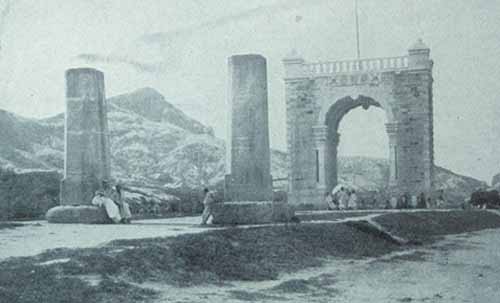
Dongnimmun, or Independence Gate, also stands as a symbol of the Korean Empire’s appreciation of Western cultures. It is modeled after France’s Arc de Triomphe, but the significance of this seemingly common gate’s construction is far greater. To make way for the gate, Koreans tore down Yeongeunmun, where Korean royals greeted Chinese envoys. Although the removal of the gate was a largely symbolic gesture, it was a loud and clear declaration to the world that the country would no longer endure the Chinese meddling in state affairs nor repeated Japanese attempts to invade.
8. Hwangudan
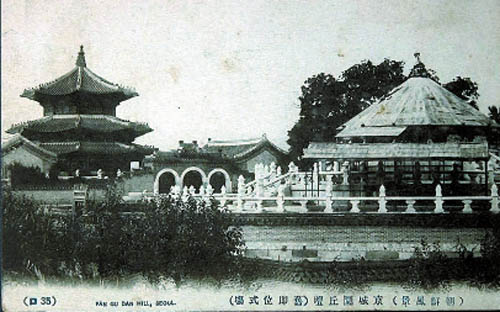
To get a feel for the Korean Empire, one should certainly stop by Hwangudan (also called Wongudan), an altar for religious ceremonies. It was here that Gojong declared himself the new leader of this new empire on Oct. 12, 1897. Hwangudan and several other structures formed a significant complex back then. Today the Westin Chosun Hotel stands where Hwangudan used to be, and only a handful of other structures remain, including the octagonal shrine in this picture. Partial restoration is under way: the main gate, found accidently in Ui-dong, northern Seoul, will be installed near its original site later this year.
9. Deoksu Palace I
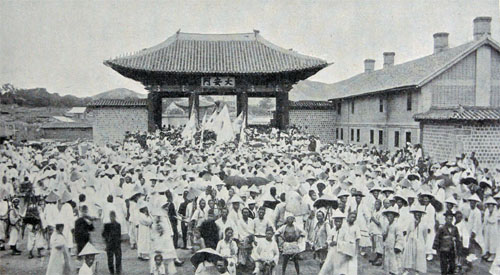
One of the most important backdrops for the Korean Empire is, without a doubt, Deoksu Palace, Gojong’s home for the last 23 years of his life. This was where he took refuge after losing his wife, Queen Min, also known as Empress Myeongseong, to Japanese assassins in Gyeongbok Palace. It was also where he ruled the short-lived empire and where he was forced to sign, under duress, the Japan-Korea Protectorate Treaty in 1905, which laid the foundation for annexation in 1910. Due to fire and other unavoidable incidents, it is regrettable that the Deoksu Palace we know today is just one-third its original size.
10. Deoksu Palace II

The tenth installment featured just the Western structures in and around Deoksu Palace. Some of these were built in a colonial style, and Seokjojeon is a classic example. Others display a unique mix of Western and Eastern architectural styles, for instance Jeonggwanheon, where Gojong is known to have fallen in love with the taste of coffee. While architectural historians note that Western structures exist within traditional palaces in other countries like China, those built within Deoksu signify the opening of Korea to foreign cultures.
*All photos provided by Myongji University - LG Yeonam Library










with the Korea JoongAng Daily
To write comments, please log in to one of the accounts.
Standards Board Policy (0/250자)